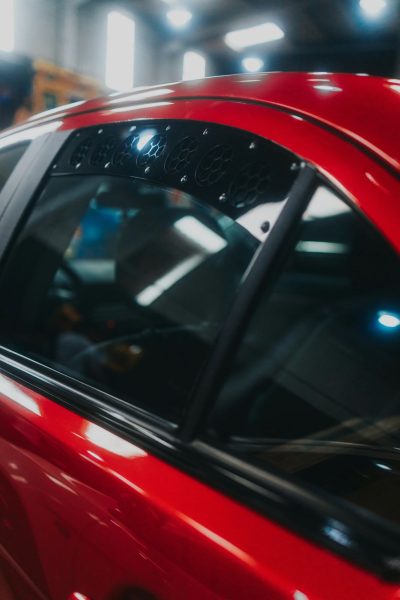
Professional window tinting offers numerous benefits for vehicle owners in San Diego and beyond. From UV protection and heat reduction to enhanced privacy and aesthetics, quality window tints are a worthwhile investment for any vehicle. However, one question frequently asked by customers is about the window tint lifespan.
At Enhanced Automotive, we understand this concern. That’s why we’ve created this comprehensive guide to help you understand exactly how long professional window tints last and what factors influence their durability.
Factors Affecting Window Tint Lifespan
Several key factors determine how long your window tints will maintain their appearance and functionality. The quality of the film used is perhaps the most significant factor. Premium films from reputable manufacturers typically last significantly longer than budget options.
Installation quality also plays a crucial role. Properly installed window tints by certified professionals avoid common issues like bubbling, peeling, and premature fading that can shorten tint life.
Climate exposure is another major consideration. Vehicles constantly exposed to intense sunlight and extreme temperatures may experience faster deterioration of their window tints compared to those kept in garages or moderate climates.
Different Types of Window Tints and Their Life Expectancy
Not all window tints are created equal. Each type offers different benefits and window tint life expectations:
- Dyed Window Film: 2-5 years
- Most affordable option
- Provides privacy but minimal heat rejection
- Prone to fading with continuous sun exposure
- Metalized Film: 5-10 years
- Contains small metallic particles that reflect heat
- More durable than dyed films
- May interfere with electronic signals
- Carbon Film: 7-12 years
- Excellent heat rejection properties
- Doesn’t fade as quickly as dyed films
- Doesn’t interfere with electronics
- Ceramic Film: 10-15+ years
- Premium option with superior heat rejection
- Exceptional clarity and no signal interference
- Most durable and longest-lasting type
Signs Your Window Tint Needs Replacement
Knowing when to replace your window tint is essential for maintaining your vehicle’s appearance and protection. Bubbling or peeling edges are often the first signs of degradation, especially in older or poorly installed tints.
Color changes like purple discoloration indicate UV damage to the film. This typically happens when lower-quality dyed films break down from sun exposure.
If you notice reduced heat rejection or increased glare when driving, this could indicate your tint’s functional properties are deteriorating. Most importantly, any tint that obstructs your visibility should be replaced immediately for safety reasons.
How to Maximize Window Tint Life Through Proper Care
Proper maintenance can significantly extend how long tints last on your vehicle. Allow newly installed tint to cure completely before cleaning (typically 3-7 days depending on climate and tint type).
When cleaning tinted windows, use ammonia-free products specifically designed for window tints. Harsh chemicals can break down the adhesive and damage the film. Always use a soft microfiber cloth rather than abrasive materials that might scratch the surface.
Additionally, try to park in shaded areas or use a car cover when possible to reduce extended direct sunlight exposure, which can accelerate deterioration of even high-quality films.
Common Misconceptions About How Long Tints Last
There are several myths about window tinting that can lead to unrealistic expectations about longevity:
- “All window tints last the same amount of time”
- Reality: Different quality levels and materials have vastly different lifespans
- “Window tint should last the lifetime of your vehicle”
- Reality: Even premium tints eventually need replacement
- “Bubbling is normal as tint ages”
- Reality: Bubbling typically indicates installation problems or damage
- “DIY installation saves money without affecting lifespan”
- Reality: Professional installation significantly impacts window tint lifespan
Professional vs. DIY Window Tinting: Longevity Comparison
The installation process directly impacts window tint life. Professional installations from certified technicians like those at Enhanced Automotive ensure precise cutting, proper cleaning of surfaces, and controlled application environments.
DIY installations often result in imperfections like dust particles trapped under the film, improper adhesion, and bubbling. These issues not only affect appearance but can reduce lifespan by 50% or more compared to professionally installed films.
Professional installers also have access to premium films that aren’t typically available to consumers. These higher-grade materials offer superior longevity and performance benefits that make the investment worthwhile.
Investing in Quality: The Enhanced Automotive Difference
At Enhanced Automotive, we pride ourselves on providing San Diego vehicle owners with premium window tinting solutions designed to maximize window tint lifespan. Our certified technicians use only top-quality films and follow manufacturer-specified installation procedures.
We stand behind our work with warranties that reflect our confidence in how long tints last when properly installed. By choosing Enhanced Automotive for your window tinting needs, you’re not just getting temporary enhancement—you’re making a long-term investment in your vehicle’s protection and appearance.
Contact Enhanced Automotive today for a free window tinting quote and discover why we’re San Diego’s trusted window tinting specialists.
